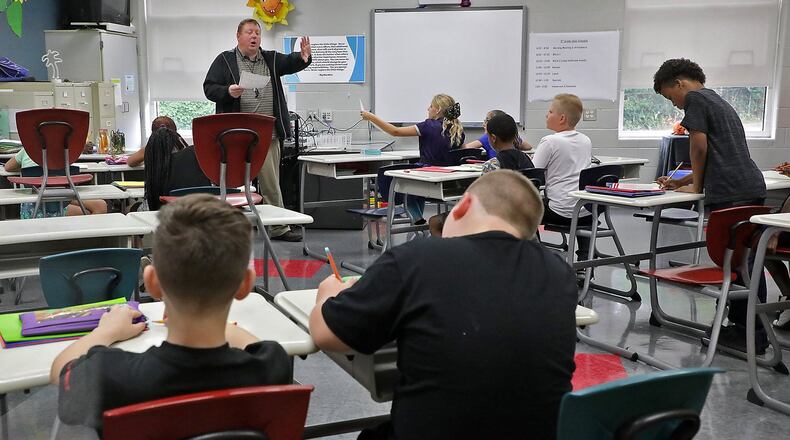Springfield City School District Superintendent Bob Hill said many people don’t look deep enough at report card data to understand that student populations between schools can be very different. He said percentages of students in poverty, English language learners, students with disabilities and student mobility are correlated to test scores.
“This comparison unfairly paints a picture of a school or teacher as bad, or failing, when in fact, that school or teacher may be excellent and may be doing a great job of helping students overcome tremendous challenges both inside and outside of school,” Hill said.
Previous coverage: How did your district do on the 2017-18 state report card?
Hill said the Springfield district welcomes high standards and accountability, and believes that parents should look closely at the needs and aspirations of their own child, and view a school’s report card as just one of many factors to consider when evaluating a school.
“Unfortunately, the imperfect system that we call the Ohio report card only tells a portion of the story. In this system, the state attempts to assign a letter grade to a set of complex metrics, many of which are so convoluted and technical that the state must release multi-page documents to attempt to explain them or for some, mathematical calculation that are proprietary and that they are not legally allowed to disclose,” Hill said.
It’s not just struggling schools that dislike the report card. Oakwood schools regularly rank in Ohio’s top 10 for achievement, but Superintendent Kyle Ramey has said the state report cards, “serve little or no purpose to improving learning.”
Hill echoed that, saying Springfield finds value instead in real-time metrics to guide ongoing instruction.
The Ohio Department of Education stands by the value of the state report cards, saying this week that they give, “a clear picture of the progress of Ohio’s districts and schools in raising achievement and preparing students for the future.”
But several other school superintendents in the region agreed with Hill, and said the report card was a thing they hope to see change in state education policy.
“It’s ever-changing, confusing to the public, and a one-time snap-shot that does not tell the whole success story of a student,” Piqua Superintendent Dwayne Thompson said. “Colleges, employers, and military do not ask for state test scores of students.”
Local education: West Liberty-Salem installs $30K cameras on school buses
State Superintendent Paolo DeMaria pointed out that the state finally slowed the number of changes to the report card the past two years. But he agreed with Thompson and Hill on one front — that the report card does not tell the whole story.
“I think it measures important things, but not all the things that are important are measured by the report card,” DeMaria said. “If you really want to understand what’s going on in a school, visit the school, talk to the school’s leadership, talk to students, talk to parents who send their children to those schools, interact with the staff of the school. That will always give you a better-rounded portrayal of what’s happening.”
DeMaria said things like school culture and extra-curricular activities have a definite impact on educational success but are difficult to measure, and are not part of the report card. Many academic courses outside of English, math and a few science and social studies also are not reflected.
Parts of state and federal law require ODE to produce a detailed state report card for schools with data in certain categories. The level of disagreement over the process is such that the report card has simultaneously been called too complicated and too simplistic.
Those who argue it’s too complicated often point to mathematical formulas for summarizing students growth, gap closing, “prepared for success,” and more. Those in the “overly simplistic” camp say a single letter grade can’t fairly encompass the varied, year-long experience of thousands of students in a school district.
“There is certainly some valuable data and information included in the state report cards, and we will utilize that data to make strategic decisions so that we can better meet the needs of the students that we serve,” Fairfield Superintendent Billy Smith said. “However, this report card does not define us as a district or capture all of the wonderful things that are happening in our school buildings.”
The state test results that form the backbone of the report card have long been closely correlated to wealth and poverty. Schools in higher-income communities generally test well, while those in lower-income areas usually score lower.
Local education: Northeastern working 'tirelessly' to lower costs of new schools
For years, the Ohio Schools Board Association has raised that concern. If 5-year-olds in high-poverty schools are far behind other local schools on the state’s Kindergarten Readiness Assessment on Day 1 — before school staff have ever worked with them — how much does the school deserve a bad grade when those students remain behind years later?
DeMaria said student growth measures in the report card are an effort to address that, acknowledging the, “different starting point,” of many rich and poor districts.
“We can quibble over whether (the calculation) is right or understandable or what have you, but the concept of having a progress measure is sound from a fairness perspective,” he said. “The overall letter grade (which weighs student progress) is less correlated to socioeconomic status than achievement only, which is what you want in terms of fair portrayal of the impact schools are having.”
As schools weigh their report card results this week, more changes are likely in the coming years. In its July budget bill, the state legislature mandated a review of the report card, with a report and recommendations due Dec. 15 DeMaria said the group has not met yet.
About the Author

